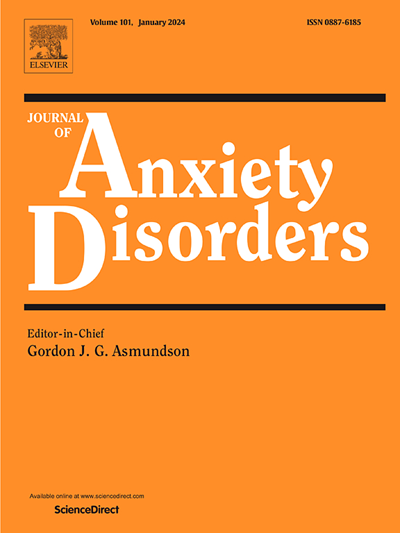The role of tonic immobility during re-experiencing trauma in PTSD treatment
IF 4.5
2区 医学
Q1 PSYCHIATRY
引用次数: 0
Abstract
Tonic immobility (TI) is a profound paralysis that may occur during extreme stress. Previous studies have found that TI during trauma was associated with poorer recovery from posttraumatic stress disorder (PTSD). Importantly, TI can re-occur during re-experiencing the trauma (TIre-exp). It is unclear whether TIre-exp also hinders recovery from PTSD or declines along with other PTSD symptoms after treatment. We examined whether pre-treatment self-reported TIre-exp would predict PTSD symptoms after trauma-focused treatment, including related constructs as depression and dissociation. and investigated pre- to post-treatment changes in TIre-exp. We also explored individual differences in TIre-exp course. A total of 257 patients with PTSD, referred to a clinic for intensive trauma-focused therapy, completed measures for PTSD symptoms and TIre-exp at pre- and posttreatment, and potential confounding variables (dissociative tendencies, somatoform dissociation, dissociative subtype, and depression) at pre-treatment. Higher pre-treatment TIre-exp predicted elevated post-treatment PTSD symptoms, but not after controlling for potentially confounding constructs. Overall, TIre-exp decreased from pre- to post-treatment, and a greater decrease in TIre-exp was associated with a greater decrease in PTSD symptoms. However, four distinct clusters could be identified, which differed in TIre-exp course: High-stable, High-decrease, Moderate and Low TIre-exp. End-state was worse for patients in the High-stable and Moderate clusters. Thus, in the general sample, pre-treatment TIre-exp was not associated with reduced recovery, and TIre-exp generally decreased after treatment, suggesting that TIre-exp may be related to the PTSD symptomatology, responding well to trauma-focused CBT treatment. However, TIre-exp may not decline in specific patient groups. Future research may address how TIre-exp can be targeted for these patients.
强直静止在创伤再体验治疗中的作用
强直性静止(TI)是一种在极端压力下可能发生的深度瘫痪。先前的研究发现,创伤期间的TI与创伤后应激障碍(PTSD)的较差恢复有关。重要的是,在重新经历创伤(轮胎-exp)时,TI可以再次发生。目前尚不清楚TIre-exp是否也会阻碍PTSD的恢复,或在治疗后随着其他PTSD症状一起下降。我们研究了治疗前自我报告的TIre-exp是否能预测创伤性治疗后的PTSD症状,包括抑郁和分离等相关构念。并研究了TIre-exp处理前后的变化。我们还在TIre-exp课程中探讨了个体差异。共有257名PTSD患者被转介到一家诊所接受强化创伤治疗,在治疗前和治疗后完成PTSD症状和TIre-exp的测量,并在治疗前完成潜在的混淆变量(分离倾向、躯体形式分离、分离亚型和抑郁)。较高的治疗前TIre-exp预测了治疗后PTSD症状的升高,但在控制了潜在的混杂因素后则不然。总体而言,TIre-exp从治疗前到治疗后下降,并且TIre-exp的更大下降与创伤后应激障碍症状的更大减少有关。然而,在不同的轮胎经验过程中,可以识别出四个明显的集群:高稳定、高减少、中等和低轮胎经验。高稳定组和中度组患者的终末状态更差。因此,在一般样本中,治疗前的TIre-exp与恢复降低无关,治疗后的TIre-exp普遍下降,提示TIre-exp可能与PTSD症状有关,对创伤性CBT治疗反应良好。然而,在特定的患者群体中,TIre-exp可能不会下降。未来的研究可能会解决TIre-exp如何针对这些患者。
本文章由计算机程序翻译,如有差异,请以英文原文为准。
求助全文
约1分钟内获得全文
求助全文
来源期刊

Journal of Anxiety Disorders
Multiple-
CiteScore
16.60
自引率
2.90%
发文量
95
期刊介绍:
The Journal of Anxiety Disorders is an interdisciplinary journal that publishes research papers on all aspects of anxiety disorders for individuals of all age groups, including children, adolescents, adults, and the elderly. Manuscripts that focus on disorders previously classified as anxiety disorders such as obsessive-compulsive disorder and posttraumatic stress disorder, as well as the new category of illness anxiety disorder, are also within the scope of the journal. The research areas of focus include traditional, behavioral, cognitive, and biological assessment; diagnosis and classification; psychosocial and psychopharmacological treatment; genetics; epidemiology; and prevention. The journal welcomes theoretical and review articles that significantly contribute to current knowledge in the field. It is abstracted and indexed in various databases such as Elsevier, BIOBASE, PubMed/Medline, PsycINFO, BIOSIS Citation Index, BRS Data, Current Contents - Social & Behavioral Sciences, Pascal Francis, Scopus, and Google Scholar.
 求助内容:
求助内容: 应助结果提醒方式:
应助结果提醒方式:


